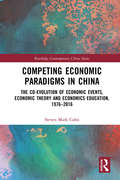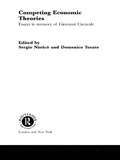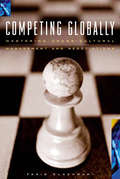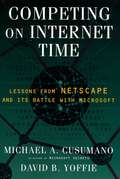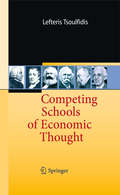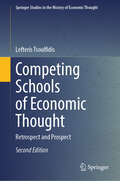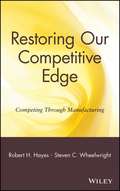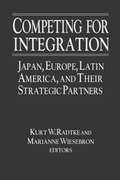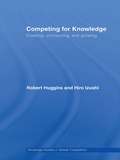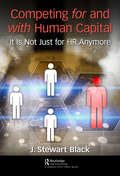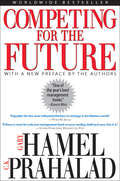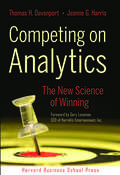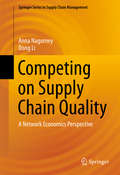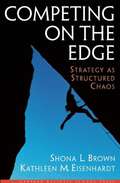- Table View
- List View
Competing Economic Paradigms in China: The Co-Evolution of Economic Events, Economic Theory and Economics Education, 1976–2016 (Routledge Contemporary China Series)
by Steven Mark CohnWhen the Chinese economic reforms began in 1978, Marxist economics infused all the institutions of economic theory in China, from academic departments and economics journals to government departments and economic think tanks. By the year 2000, neoclassical economics dominated these institutions and organized most economic discussion. This book explains how and why neoclassical economic theory replaced Marxist economic theory as the dominant economics paradigm in China. It rejects the idea that the rise of neoclassical theory was a triumph of reason over ideology, and instead, using a sociology of knowledge approach, links the rise of neoclassical economics to broad ideological currents and to the political-economic projects that key social groups inside and outside China wanted to enable. The book concludes with a discussion of the nature of economic theory and economics education in China today.
Competing Economic Theories: Essays in Honour of Giovanni Caravale (Routledge Studies In The History Of Economics)
by Sergio Nisticò Domenico TosatoProviding a contemporary overview of the debate amongst theoretical stands in economics, this book brings together contributions from a number of eminent scholars. It covers important issues in methodology and the history of thought, as well as economic analysis. The book is structured in five parts which:focus on the relevance of the history of ec
Competing Globally: Mastering Multicultural Management And Negotiation (Managing Cultural Differences Ser.)
by Farid Elashmawi, Ph.D.Based on his firsthand experience, Farid Elashmawi has created a concise, valuable primer to 'going global'. 'Competing Globally' gives specific information about entering international markets, negotiating, conducting meetings and presentations, and working with international partners. 'Competing Globally' sheds light on varied business cultures, including those of North America, Europe, Japan, Korea, China, Indonesia, Thailand and the Middle East. Elashmawi uses case studies, anecdotes, social tips, self-tests, and tables to provide important insights into communicating, marketing, and negotiating with organizations outside throughout the world. This book is invaluable to business managers and students who need to enhance their cross-cultural negotiation skills to compete globally.
Competing Interest Groups and Lobbying in the Construction of the European Banking Union
by Giuseppe MontalbanoThis book investigates the role of banking interest groups and lobbying in the making of the European Banking Union. Facing the politicization of financial regulation in the wake of the crisis, core players of the European banking industry managed to adapt and re-orient their lobbying resources and strategies to influence the reform process. This work advances an original Critical IPE approach, which combines structural power, the collective agency of key socio-economic groups and the issue salience as critical determinants to explain corporate influence in policy-making. The explanatory framework is applied to a comprehensive analysis, tracing the Banking Union’s development within the broader context of the EU post-crisis banking regulation. An in-depth scrutiny of the interest groups’ preferences, coalitions and attainments is thus provided on the pillars of the Banking Union, covering banking supervision, resolution, deposit insurance, as well as the reform of the banks’ prudential requirements and the failed project of an EU banking structural reform.
Competing On Internet Time
by David B. Yoffie Michael A. CusumanoCompeting on Internet time means competitive advantage can be won and lost overnight. In this penetrating analysis of strategy-making and product innovation in the dynamic markets of commercial cyberspace, bestselling Microsoft Secrets co-author Michael Cusumano and top competitive strategy expert David Yoffie draw vital lessons from Netscape, the first pure Internet company, and how it has employed the techniques of "judo strategy" in its pitched battle with Microsoft, the world's largest software producer. From on-site observation and more than 50 in-depth interviews at Netscape and other companies, Cusumano and Yoffie construct a blueprint meticulously detailing how the fastest-growing software company in history has competed on Internet time by moving rapidly to new products and markets, staying flexible, and exploiting leverage that uses the weight of its giant rival Microsoft against it. The main source of Netscape's leverage, they argue, has been its skill in designing products that run on multiple operating systems. Microsoft has responded with judo techniques in kind. Managers in every high-tech industry will discover a wealth of new ideas on how to create and scale-up a new company quickly; how to compete in fast-paced, unpredictable industries; and how to design products for rapidly evolving markets. The lessons that Cusumano and Yoffie derive from Netscape's contest with Microsoft go far beyond start-ups and Internet software. Small companies in any industry and powerful, established firms alike will welcome the principles the authors formulate from this David-and-Goliath-like struggle. Competing on Internet Time is essential and instructive reading for all managers, engineers, and entrepreneurs who want to succeed in ultra-fast-paced markets.
Competing Schools of Economic Thought
by Lefteris TsoulfidisThe greatest works of economists have the potential to provide insights on current economic developments and policy challenges long after they are written. This book seeks to investigate the evolution of the core ideas and policy recommendations of the major schools of economic thought, and to present and critically evaluate those theories that have survived over time and can inform us about current developments and economic policies. The theories of major economists are presented and used to promote an understanding of the underlying mechanisms of the economy and to address contemporary problems and issues. In addition, the book explores the fascinating dynamics of shifting from one school of economic thought to another. Each chapter concludes with a summary, critical remarks, a set of questions for reflection and discussion, and recommendations for further reading.
Competing Schools of Economic Thought: Retrospect and Prospect (Springer Studies in the History of Economic Thought)
by Lefteris TsoulfidisThis book presents a comprehensive overview of the development of various schools of economic thought. Written for students of economics and anyone interested in the history of economics, it introduces the economic thinking of major economists, including Adam Smith, David Ricardo, Karl Marx, and John Maynard Keynes, and explains how classical economics and modern schools of economic thought evolved also in relation to the social conditions and real economic problems they were trying to address. It covers topics such as the evolution of classical economics, the marginal revolution, the theory of capital and the Cambridge controversies, Keynes’s General Theory, the neoclassical synthesis, and the history of macroeconomics. The author also reflects on the contemporary influence of various schools of economic thought and what answers they offer to present-day problems. The second edition is completely updated and offers two new chapters, one on the methodology of economics and another on economic growth. The final chapter presents and critically evaluates developments in macroeconomics in the years after the "Great Recession."
Competing Through Business Models (A): Business Model Essentials, Module Note
by Ramon Casadesus-Masanell Joan Enric Ricart CostaThis note defines the concepts of business model and the value loop. It also introduces business model representations and proposes four tests for evaluating business models in isolation. This is the first note in a series of three written for the HBS elective course "Competing through Business Models."
Competing Through Manufacturing
by Steven C. Wheelwright Robert H. HayesThe different roles that manufacturing can play in a company's efforts to formulate and achieve its strategic objectives can be described in terms of a developmental continuum. At the lowest "internally neutral" stage, top managers regard production as a low-tech operation, incapable of influencing competitive success. Stage 2 companies seek an "externally neutral" parity with major competitors on the manufacturing dimension. This attitude is often found in America's smokestack industries. Stage 3 organizations, on the other hand, expect production to support and strengthen the company's competitive position, and manufacturing investments are screened for consistency with the business strategy. The fourth and most progressive stage arises when competitive strategy rests to a significant degree on a company's production capability.
Competing against Multinationals in Emerging Markets: Case Studies of SMEs in the Manufacturing Sector
by Densil A. WilliamsCompeting against Multinationals in Emerging Markets provides a comprehensive set of lessons which successful small firms have adopted in order to survive and prosper in an increasingly hostile competitive manufacturing sector where large firms are mostly dominant.
Competing for Industry Foresight
by Gary Hamel C. K. PrahaladIndustry foresight gives a company the potential to get to the future first and stake out a leadership position. This chapter shows how to develop the prescience needed to proactively shape industry evolution.
Competing for Integration: Japan, Europe, Latin America and Their Strategic Partners
by Kurt W. Radtke Marianne Wiesbron Marianne WiesebronThis study demonstrates why the global economy and global policies can only be understood by assigning equal importance to actors from different continents and international institutions. The contributors begin by examining the effects of reducing trade barriers through the WTO processes, and the implications for our understanding of market forces, the diminishing capacity of governments, consumer power, and the role of international agreements. They provide fascinating details on how the European Union and Japan develop their own strategies toward emerging Asian and Latin American states, quite separately from the United States.The focus then shifts toward integration processes in Latin America. The book concludes by attempting to make sense of the political principles underlying the complex economic policies of the main actors in today's global economy, focusing on development strategies offered by the World Bank.
Competing for Knowledge: Creating, Connecting and Growing
by Hiro Izushi Robert A HugginsWith the buzzwords of knowledge-based economy and knowledge-driven economy, policy-makers, as well as journalists and management consultants, are pushing forward a vision of change that transforms the way advanced economies work. Yet little is understood about how the knowledge-based economy differs from the old, traditional economy. It is generall
Competing for a Sustainable World: Building Capacity for Sustainable Innovation
by Sanjay SharmaSustainable innovation requires more than a clear vision and commitment. It requires effective execution and implementation based on an ongoing systematic process of engaging stakeholders to generate the evolving information critical for guiding decision-making, developing and implementing business logic for sustainable innovation, overcoming decision-making biases by managers, creating an opportunity framework to spark creativity, and developing effective organizational capabilities to build a sustainable innovation DNA within the organization. Such a capacity provides an organization with the ability to anticipate and overcome internal and external barriers and achieve competitive advantage through sustainable innovation of products, services, and business models. Based on original research, current state-of-the-knowledge, and relevant examples, this book comprehensively outlines and describes the process that managers can undertake to effectively and successfully implement a sustainability strategy that will help them attract and retain managerial talent; increase operating legitimacy and reduce compliance costs; boost stakeholder support; reduce costs through increased efficiency, quality, reliability, safety, and responsiveness of existing operations; foster radical innovations in processes, products, services, and new markets; and promote competitive imagination of future products, services, and business models.
Competing for and with Human Capital: It Is Not Just for HR Anymore
by J. Stewart BlackExecutives say that people are their most important asset, but most don’t walk the talk. They don’t have systematic strategies for how to get the people they want to want them. They don’t have measures and metrics for how they are doing to be the employer of choice. They don’t hold leaders accountable regarding those ambitions. In many cases, this is because top leaders don’t have concrete tools to help them do what they know they should. This book fills that gap in three major sections. The first section supports with clear and compelling data what executives intuitively but somewhat superficially believe—that people are their most important asset. The second section provides a systematic process and set of tools to help leaders get the people they want to want them; it shows executives how to win the competition for human capital. The third section then helps leaders position people appropriately so that they can create a sustainable competitive advantage; its shows executives how to compete with human capital. When it comes to human capital, most books get it wrong. Strategy books place human capital to the side as an enabler of competitive advantage. HR books treat human capital as a support activity to business strategy. This book places human capital where it should be—not to the side and not as an enabler or a support activity, but at the center and as the source of competitive advantage.
Competing for the Future
by Gary Hamel C. K. PrahaladNew competitive realities have ruptured industry boundaries, overthrown much of standard management practice, and rendered conventional models of strategy and growth obsolete. In their stead have come the powerful ideas and methodologies of Gary Hamel and C.K. Prahalad, whose much-revered thinking has already engendered a new language of strategy. In this book, they develop a coherent model for how today's executives can identify and accomplish no less than heroic goals in tomorrow's marketplace. Their masterful blueprint addresses how executives can ease the tension between competing today and clearing a path toward leadership in the future.
Competing in a Global Economy: An Empirical Study on Trade and Specialization
by Robert Ballance Helmut ForstnerGlobal patterns of production and trade in manufactures have changed tremendously over the past two decades. The growth of world trade has been accompanied by a rapid increase in the number of products, suppliers and buyers involved in international markets. At the same time, the means by which manufacturers compete and collaborate have been changing. The great challenges that these developments pose for policy makers and practitioners provide the basic motive for this comprehensive assessment of the underlying forces and determinants that are reshaping the world's industrial map. Based upon an empirical approach, the analysis is closely interwoven with key elements of economic theory. the Heckscher-Ohlin model provides the framework for most of the book's interpretation, but less formal models focusing on economies of scale, product differentiation and other aspects of imperfect competition also figure prominently. The extensive research with access to UNIDO's vast body of unpublished information and contributions from specialists, has resulted in a blend of theoretical and empirical material which yields new insights into the way firms and industries compete in international markets.
Competing on Analytics
by Thomas H. Davenport Jeanne G. HarrisYou have more information at hand about your business environment than ever before. But are you using it to "out-think" your rivals? If not, you may be missing out on a potent competitive tool.In Competing on Analytics: The New Science of Winning, Thomas H. Davenport and Jeanne G. Harris argue that the frontier for using data to make decisions has shifted dramatically. Certain high-performing enterprises are now building their competitive strategies around data-driven insights that in turn generate impressive business results. Their secret weapon? Analytics: sophisticated quantitative and statistical analysis and predictive modeling.Exemplars of analytics are using new tools to identify their most profitable customers and offer them the right price, to accelerate product innovation, to optimize supply chains, and to identify the true drivers of financial performance. A wealth of examples-from organizations as diverse as Amazon, Barclay's, Capital One, Harrah's, Procter & Gamble, Wachovia, and the Boston Red Sox-illuminate how to leverage the power of analytics.
Competing on Analytics with External Processes: Customer and Supplier Applications
by Thomas H. Davenport Jeanne G. HarrisBecause externally focused processes require cooperation from outsiders, as well as their resources, managing analytics related to external processes is a greater challenge than managing those related to processes within an organization's complete control. This chapter addresses applications of analytics to external relationships with customers and suppliers. This chapter was originally published as Chapter 5 of "Competing on Analytics."
Competing on Analytics with Internal Processes: Financial, Manufacturing, R&D, and Human Resource Applications
by Thomas H. Davenport Jeanne G. HarrisThis chapter focuses on internal business processes and the challenge not only of identifying internal applications of business analytics, but of finding some applications that are clearly strategic and involve competitive advantage. This chapter was originally published as Chapter 4 of "Competing on Analytics."
Competing on Capabilities: The New Rules of Corporate Strategy
by George Stalk Jr. Lawrence E. Shulman Philip EvansIn today's dynamic business environment, strategy too must become dynamic. The essence of strategy is not the structure of a company's products but the dynamics of its behavior. To succeed, a company must weave its key business processes into hard-to-imitate strategic capabilities that distinguish it from its competitors. A capability is a set of business processes understood strategically. While such capabilities are collective and cross-functional, they must be built and managed by the CEO. Uses examples from Wal-Mart.
Competing on Supply Chain Quality: A Network Economics Perspective (Springer Series in Supply Chain Management #2)
by Anna Nagurney Dong LiThis book lays the foundations for quality modeling and analysis in the context of supply chains through a synthesis of the economics, operations management, as well as operations research/management science literature on quality. The reality of today's supply chain networks, given their global reach from sourcing locations to points of demand, is further challenged by such issues as the growth in outsourcing as well as the information asymmetry associated with what producers know about the quality of their products and what consumers know. Although much of the related literature has focused on the micro aspects of supply chain networks, considering two or three decision-makers, it is essential to capture the scale of supply chain networks in a holistic manner that occurs in practice in order to be able to evaluate and analyze the competition and the impacts on supply chain quality in a quantifiable manner. This volume provides an overview of the fundamental methodologies utilized in this book, including optimization theory, game theory, variational inequality theory, and projected dynamical systems theory. It then focuses on major issues in today's supply chains with respect to quality, beginning with information asymmetry, followed by product differentiation and branding, the outsourcing of production, from components to final products, to quality in freight service provision. The book is filled with numerous real-life examples in order to emphasize the generality and pragmatism of the models and tools. The novelty of the framework lies in a network economics perspective through which the authors identify the underlying network structure of the various supply chains, coupled with the behavior of the decision-makers, ranging from suppliers and manufacturers to freight service providers. What is meant by quality is rigorously defined and quantified. The authors explore the underlying dynamics associated with the competitive processes along with the equilibrium solutions. As appropriate, the supply chain decision-makers compete in terms of quantity and quality, or in price and quality. The relevance of the various models that are developed to specific industrial sectors, including pharmaceuticals and high technology products, is clearly made. Qualitative analyses are provided, along with effective, and, easy to implement, computational procedures. Finally, the impacts of policy interventions, in the form of minimum quality standards, and their ramifications, in terms of product prices, quality levels, as well as profits are explored. The book is filled with many network figures, graphs, and tables with data.
Competing on the Edge: Strategy as Structured Chaos
by Shona L. Brown Kathleen M. EisenhardtCompeting on the edge is an unpredictable, uncontrollable, often even inefficient strategy, yet a singularly effective one in an era driven by change. By linking the practical concerns of business managers to some of the most exciting ideas from science concerning complexity and evolution, the authors have created a bold new strategy that harnesses the dynamic nature of change to create a continuous flow of competitive advantages.
Competing on the Eight Dimensions of Quality
by David A. GarvinTraditional programs of quality control in the United States have emphasized mainly defensive actions--preventing defects--and even these programs have been pursued halfheartedly. But high quality means pleasing consumers, not just protecting them from annoyances. Therefore, U.S. consumers have become skeptical about the quality of goods and services offered by U.S. corporations, while Japanese electronics, automobile, and semiconductor companies have come to dominate important U.S. markets. In order for a company to compete on quality deliberately and strategically, its managers must first divide the concept into manageable parts--the eight dimensions of quality by which consumers judge products: performance, features, reliability, conformance, durability, serviceability, aesthetics, and perceived quality. Managers should research potential markets and the strengths of their competition to ascertain which of these dimensions they can emphasize.
